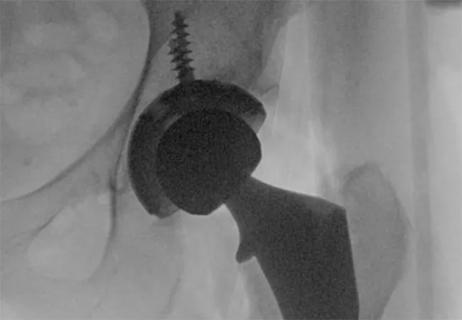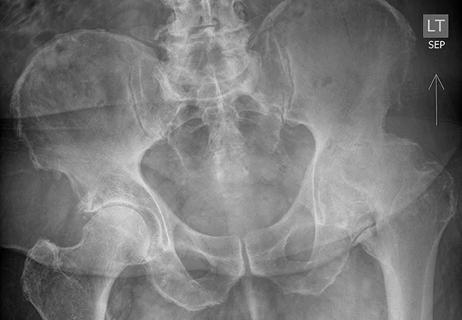Cleveland Clinic is among the first in the U.S. to perform the procedure

Cleveland Clinic is among the first medical centers in the U.S. to perform revision hip arthroplasty with robot assistance. The surgery, which took place this spring, is the nation’s second to incorporate a novel CT-based robotic-arm system (Mako SmartRobotics™).
Advertisement
Cleveland Clinic is a non-profit academic medical center. Advertising on our site helps support our mission. We do not endorse non-Cleveland Clinic products or services. Policy
While using robotic platforms for joint replacement is common at Cleveland Clinic, only recently have technological advances made it possible for hip revision.
“Most robotic platforms rely on imaging, and imaging joint prostheses is different than imaging native bone,” says Peter Surace, MD, the orthopaedic surgeon who performed the first robot-assisted hip revision at Cleveland Clinic. “The new technology allows us to use CT scans to plan around previous hip implants, accounting for elements such as the femoral stem and acetabular component. It has a high degree of fidelity in registering periprosthetic bone as well.”
Compared with conventional surgery, robot-assisted hip revision requires less manual assessment and guesswork, says Dr. Surace.
“Conventionally, hip surgeons manually ream for a large socket and determine where to place screws — which involves drilling and measuring and hoping the screws are affixed to good bone,” he says. “If we need an acetabular augment, we put that in manually. After the acetabulum, we ream to get what we think is good fixation with the femur. We determine leg length and offset based on intraoperative feel.”
With the robotic platform, those steps are precisely planned ahead of time, in 3D, using digital measurements based on CT scans of the patient’s anatomy.
“There’s no ambiguity about where the cup goes or what size cup will fit into the defect,” Dr. Surace says. “You can measure how long the screws should be and plan their trajectories to make sure they go through the cup and into good bone. You can plan for and prepare an augment, if needed. Although you don’t ream the femur with the robotic platform, you can determine stem size and, at the end of the case, get an accurate measurement of leg length and offset as opposed to trying to do it by feel on the table or with rough estimates.”
Advertisement
Published studies have demonstrated improved surgical accuracy and better outcomes when using robotic platforms for primary hip arthroplasty.
“Using a robotic platform for revision surgery likely will have an even bigger impact by taking the unexpected and making it predictable,” says Cleveland Clinic orthopaedic oncology and adult reconstruction surgeon Nathan Mesko, MD. “Giving the surgeon a solid understanding of the obstacles to be encountered in an operation, before even entering the operating room, will instill confidence and create efficiency like we have not seen before. The system will partner with the surgeon to plan all aspects of instrumenting the patient — removing a lot of guesswork, simplifying the execution of these cases and decreasing the time spent in the operating room.”
Dr. Surace’s recent robot-assisted hip revision was in a patient who had a well-fixed femoral component but loose acetabular component.

Here are the steps the surgical team performed, in Dr. Surace’s words:
Advertisement




According to Dr. Surace, the robot-assisted surgery took less time than a conventional revision surgery because the robotic platform alleviated the need to ream multiple times and second-guess screw trajectories.
“For revision with bone loss, it often requires two, three or more reamers to get an adequate press fit for the hemispheric shell,” he says. “With the robotic platform, we planned in 3D exactly how much bone to take. So, we were able to use a single reamer, which cut down on the timing of repetitive reaming, but more importantly provided a better press fit. It reduced the chance for eccentric reaming, which can happen when using multiple reamers.”
Advertisement
In revision hip surgery, which is often more demanding than primary surgery, robotic platforms have the potential to reduce risk of complication, adds Dr. Mesko.
“The rates of complication after joint revision are much higher than after primary arthroplasty,” he says. “Revision surgeons are always cognizant of the high risk of complications like dislocations, fractures, component loosening, changes in leg length or offset, infection and nerve injury. Robotic capability can help us become smarter and better prepared, which undoubtedly will prevent more of those concerns while allowing the surgical event to occur in a more controlled, more predictable and safer manner.”
Most patients needing hip revision would be candidates for robot-assisted surgery, Dr. Surace says.
“The only patients not able to have robotic surgery are those who have lost so much bone that they need a custom implant, or those with infection who need a first-stage surgery to implant an antibiotic spacer — although the robot would help with the second stage, when we’re putting in new implants,” he says. “That leaves an incredibly large percentage of patients who are candidates for surgery using the robot. For taking out an acetabular component and putting in a new one, this is a tremendous tool.”
Advertisement
Advertisement

Should surgeons forgo posterior and lateral approaches?

Multidisciplinary care can make arthroplasty a safe option even for patients with low ejection fraction

High-risk procedure prepares patient for lifesaving heart surgery

Insights to help orthopaedic practices comply with the 2025 CMS mandate

Dr. Piuzzi wins 2025 Kappa Delta Young Investigator Award for pioneering work

For patients with anatomic abnormalities, substantial bone loss and pre-existing hardware

How it actually compares to posterior and lateral approaches

Offers adequate exposure of normal and abnormal anatomy